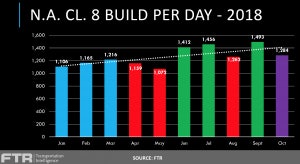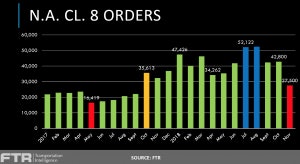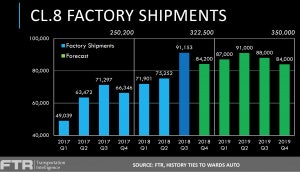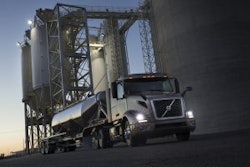A strong economy, the need to move freight, part and component shortages and a tight labor market are a few factors that have applied pressure on Class 8 truck makers and their suppliers. Today’s FTR webinar, “CV Outlook — The Heat Is On: Commercial Vehicle Markets Under Pressure to Perform,” examined what made 2018 (and could make 2019) an interesting year for the industry.
“The supplier issues started [early] and got worse,” says Don Ake, FTR vice president of commercial vehicles. “We estimate 50 or more suppliers were involved in the late deliveries or supply issues. It was estimated there were 10,000 semi-completed trucks parked at one time. We had companies, and this continues right now, air-freighting parts to keep production lines going.”
 Click to enlarge.
Click to enlarge.Ake says the situation began to improve in June, however the supply chain still remains tight.
“The industry did a great job of responding and, right now, we’re in a better position than we were but we can’t say we’re in a good position yet. We’re vulnerable to any [future] natural disasters, labor strikes and tariff issues,” he says.
Supplier issues made for an erratic production year. Class 8 builds were going well up to March when the supplier issues began, creating “abnormally” low builds per day, according to Ake. Then, deliveries arrived and manufacturers were able to finish and ship trucks at an above normal rate. There were issues again in August that created a decline in production. The supplier issues were resolved and production rebounded in September.
 Click to enlarge.
Click to enlarge.“You see the volatility in these build numbers and, as a result, you’ve seen the FTR forecast fluctuate much more than you would in a typical year. We’re hoping at this point suppliers are supplying at a pretty constant rate and the data becomes much more consistent,” Ake says.
The year also included record-breaking months for truck orders, notably July and August. However, Ake says not to be surprised if December orders dip below 20,000.
“What we’re finding is that some of the OEMs are running out of build slots and that’s slowing down the orders some. It’s just a matter of fleets having their orders in for 2018 … or the build slots they would want are already filled,” he says.
 Click to enlarge.
Click to enlarge.With fleets placing big orders nine to 12 months out to reserve build slots in anticipation of business remaining strong all of next year, “2019 is going to be a wild year,” Ake says, referring fleets moving around orders or canceling them — and the OEMs having to respond to that by adjusting their production cycles.
“I expect the cancellation rate to start to increase around June when fleets start to look at what their true demand is in the second half,” Ake says. “You have all these orders in the system. Some are going to be moved, some are going to be canceled. It’s going to be difficult to establish what true demand is and we’ll have to watch those OEM production schedules very closely to see where demand goes.”











